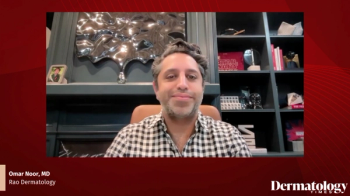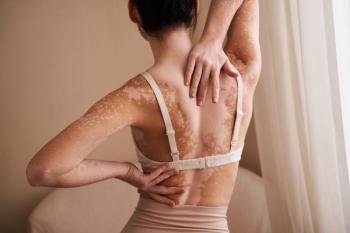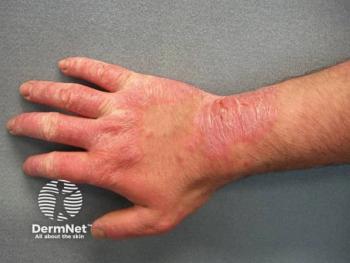
- Dermatology Times, June 2025 (Vol. 46. No. 06)
- Volume 46
- Issue 06
Inside IL-17 Inhibitors Advancing Psoriasis Care
Explore the latest insights on IL-17 inhibitors for psoriasis, highlighting their mechanisms, real-world benefits, and future treatment strategies.
The recent Dermatology Times DermView custom video series
Hosted by Dermatology Times Editor in Chief Christopher Bunick, MD, PhD, associate professor of dermatology at Yale School of Medicine; and James Song, MD, co–chief medical officer and clinical research director at Frontier Dermatology, the series synthesizes cutting-edge research, clinical trial outcomes, and practical insights to guide evidence-based care.
The Role of IL-17 in Psoriasis
The series begins with a discussion of IL-17’s role in psoriasis pathophysiology. IL-17A and IL-17F, produced by TH17 cells and other innate immune cells, are pivotal in driving keratinocyte hyperproliferation and immune cell recruitment—hallmarks of plaque psoriasis.
Bunick and Song emphasize that IL-17A is more potent, whereas IL-17F is more abundant in tissues, making dual inhibition a promising therapeutic strategy. Importantly, IL-17 can be produced via IL-23-dependent and -independent pathways, necessitating treatment approaches that address both mechanisms.
Mechanisms of IL-17 Inhibition
Currently, there are 4 IL-17 inhibitors are FDA approved in the US for plaque psoriasis: secukinumab, ixekizumab, brodalumab, and bimekizumab. These agents differ in their mechanisms of action:
- Secukinumab and ixekizumab target IL-17A, with ixekizumab demonstrating tighter binding affinity and longer receptor engagement, potentially translating into enhanced efficacy.
- Brodalumab targets the IL-17 receptor A (IL-17RA), thereby blocking the activity of several IL-17 isoforms including IL-17A and F, but does not neutralize the cytokines directly.
- Bimekizumab, the newest entrant, targets both IL-17A and IL-17F directly, addressing both potency and abundance in disease pathogenesis.
This molecular specificity underlies the observed differences in the onset and magnitude of clinical response and the nuanced safety profiles across the class.
Real-World Application
The video series incorporates real-world patient experiences, underscoring the transformative potential of IL-17 inhibitors. One patient, treated with ixekizumab, achieved complete skin clearance (PASI 100) and experienced total relief from psoriatic joint pain, highlighting the dual benefits in both cutaneous and musculoskeletal symptoms.
Bunick stresses the importance of integrating quality-of-life assessments and joint symptom evaluations into routine practice. Early recognition of psoriatic arthritis symptoms such as morning stiffness, nocturnal back pain, and enthesitis (eg, heel pain) can help guide optimal therapeutic selection, particularly toward agents with robust joint efficacy data.
Safety Considerations
IL-17 inhibitors are generally well tolerated with favorable safety profiles compared with tumor necrosis factor (TNF) inhibitors and older biologics. The most commonly reported adverse effects include upper respiratory infections, headache, and nasopharyngitis. However, unique to the IL-17 class are concerns about:
- Candida infections, particularly oropharyngeal candidiasis, due to IL-17’s role in mucocutaneous immunity
- Inflammatory bowel disease flare risk
- Suicidal ideation and behavior (SIB), most notably flagged in brodalumab studies, though newer trials using standardized depression scales show these events are rare and may reflect surveillance bias more than a true pharmacologic risk
Bunick and Song agree that candidiasis, while more common with dual IL-17A/F blockade, is manageable and not typically treatment limiting. Similarly, SIB concerns should prompt clinician awareness but are not contraindications to therapy.
Head-to-Head Trials
The discussion emphasizes the importance of head-to-head clinical trials and indirect network meta-analyses in guiding therapeutic choice. While many IL-17 inhibitors have demonstrated superiority over older therapies such as TNF inhibitors and IL-12/23 agents in rapidity and magnitude of skin clearance, recent trials offer deeper insights:
- The BE RADIANT study (NCT03536884) showed bimekizumab’s superiority over secukinumab in skin clearance.
- Another head-to-head trial in psoriatic arthritis found bimekizumab outperforming adalimumab, challenging the traditional belief that TNF inhibitors are the gold standard for joint disease.
- The BE BOLD trial (NCT06624228), currently underway, pits bimekizumab against risankizumab (a leading IL-23 inhibitor), aiming to determine which agent delivers superior PASI 100 outcomes and joint improvement, with composite treatment targets in mind.
These trials reinforce the notion that not all biologics within a class are interchangeable, and mechanistic differences can lead to meaningful clinical outcomes.
Future Directions and Strategies
A promising area of innovation involves coupling biologics with glucagon-like peptide-1 receptor agonists patients with obesity or who are overweight. These agents may enhance psoriasis outcomes through weight loss and possibly independent anti-inflammatory mechanisms.
Bunick and Song advocate for a holistic approach that includes metabolic health management alongside skin and joint disease control. Such strategies may improve quality of life and long-term outcomes, including cardiovascular risk and life expectancy.
Conclusion
The DermView series A Closer Look at IL-17 Inhibitors in Psoriasis is a timely, comprehensive, and clinically relevant examination of a pivotal therapeutic class. Bunick and Song illuminate how IL-17 inhibitors, particularly agents targeting both IL-17A and F, redefine psoriasis care by offering fast, durable, and multidimensional relief.
As the therapeutic landscape evolves, the emphasis on patient-centered care, safety vigilance, and precision in drug selection will remain central to optimizing outcomes in psoriasis and psoriatic arthritis.
Articles in this issue
5 months ago
Dermatology Times June 2025 Print Recap6 months ago
Nail Trends That Challenge Clinical DiagnosisNewsletter
Like what you’re reading? Subscribe to Dermatology Times for weekly updates on therapies, innovations, and real-world practice tips.



















